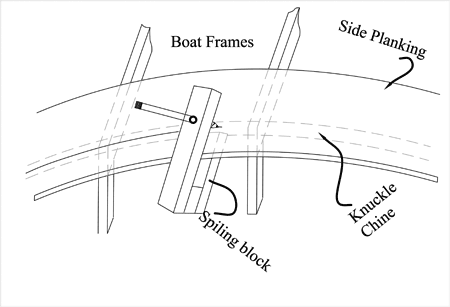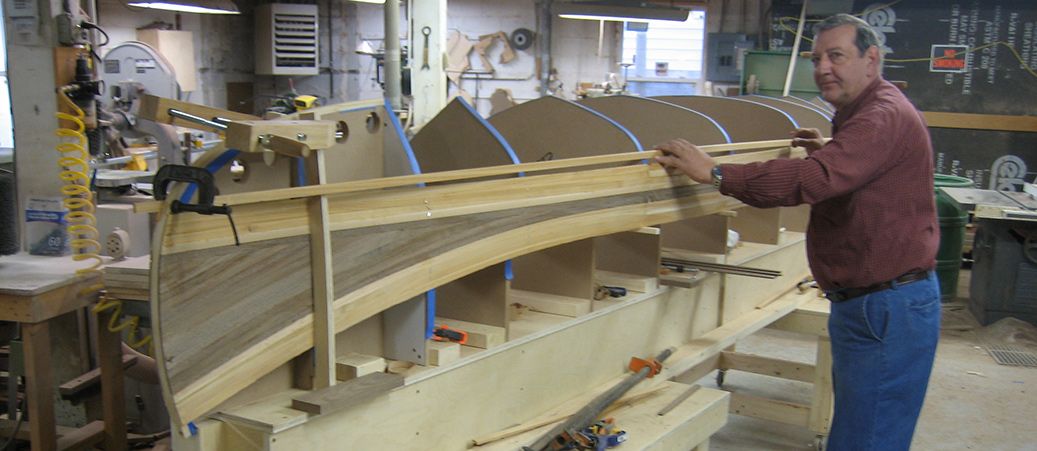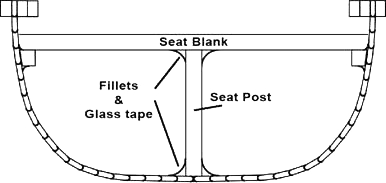Spiling, Yup, it is a real word... First, A little History
Spiling is one of those things I can write about, be completely wrong and nobody can prove it. I could not find a definition in most dictionaries I checked, articles I have read on it are brief, non-descript and single focused and boat building books going back to the masters of the likes of Howard Chapelle, leave enormous room for interpretation. I think the reason for this is because most people try to define spiling as a specific action instead of a goal. Even as I write this article, the spell checker refuses to accept the word.
Building a Dory Skiff Boat
Starting with the Frames
Hopefully this blog will take you on a boat building trip with me as I build an 18' power dory skiff. The construction method is unique using plywood planking over frames. I considered building this boat using stitch and glue but as in most cases on boats of this size, I found that the panel size would be daunting and by the time I was done installing all of the supports I needed for the self bailing cockpit, engine splash well, decking and so forth I might just as well built it with frames to begin with.
Having built using both methods, I simply find this construction method suites me far better than stitch and glue for large boats such as this. I will typically either be working alone so trying to stitch 20 foot plywood panels is a daunting task to say the least....
The Secret of Clean Fiberglass Joints
If you have ever tried to joint two pieces of fiberglass with a lap and got frustrated with fraying ends, this article is for you.there are a few reasons to join or lap fiberglass layers on boats. Typically fiberglass comes in rolls of 60" or less in width. So if you are working on a boat such as the Pea Pod used in this discussion, you will need to have more than one layer simply to cover the hull. The second reason is to add strength to specific areas of the hull. typically the bottom. For instance if you are building a small wherry or canoe that you think will be dragged up on rocky shores, you will probably want a couple of layers on the bottom. Some boat plans have specific requirements for fiberglass layups and you should never do less than what is recomended.
When I write how-to's...
Building your canoe without staples
First, let me say that building with staples has been done many thousands of times and makes for a beautiful boat. In fact if done carefully and the staples are aligned neatly, it can be very appealing. Boat plans for canoes do not generally specify how to attach your strips as either method will work just fine. That said, if you are of the opinion that those darn little staple holes detract from the beauty of the boat then read on. The actual act of stripping without staples is a fairly easy straight forward process. There are a number of ways to accomplish it but we will get to that in a minute. The actual rub to building without staples lies in the shape of the hull. In general, if the hull has smooth curves which aren't too severe then it is a very straight forward process. When the...
Building Scuppered Canoe Gunwales
Adding a little dash to your Canoe!
Even if your canoe plans don't specifically call for them, you would be surprised just how easy it is to add a little flair to your canoe or rowing craft. Scuppers not only add to the looks, they also serve a purpose. when you flip your boat over it gives the water a way to exit the craft. Scuppers on bigger (trailered craft) are pretty much just for looks. As most of you know, when it comes to building your own boat, there is nothing wrong with doing something just for looks.
First a little disclosure before we start making our scuppered gunwales. All of the gunwales we have here at our shop whether we are using them here or sending them out to customers are cut by machine out of long pieces of Ash. Although this is preferable, making them as outlined...
Building a Laminated Stem for Large Boats
arge clear timber is getting hard to come by. This simple technique will cost you about $100 in tools, glue and jig material and give you a rock solid stem with a perfect shape. In years gone by, boat plans called for stems that were typically made from sawn timber in multiple pieces, and the pieces were glued together and assisted with through bolts. Words like rabbett and knee are seldom used on newer plans when referring to the stem. In fact most stems today are made from inner and outer stem pieces. The inner stem is actually the integral part of the hull where the outer stem typically includes the cutwater and has a primary function of protecting the bow of the boat.
Not only are these two piece stems easier to build with, they are typically much stronger than a traditional stem. If...
Lofting Basics
The Basics of Boat Lofting
Introduction
First, let me make it perfectly clear that the vast majority of the boats on our site are lofted for you and full size patterns are provided. There are very (very) few boats on our site that require lofting. Boats such as the tug boat would require a massive printer to print out patterns, and even if we could, using them would be rather impossible. In theory, if you are prepared to take on a project the size of the tug boat, you should be able to loft as it will be invaluable in the actual building process.
Let's get a piece of house cleaning out of the way first. The correct term for one who lofts is a loftsman. This person is defined as one who creates patterns or frames. For the purposes of this document, so as not to...
Relief and Filler Strips
“THE COST OF THE CURVE”
Those who know me well have heard me say at one time or another that “nothing in life is free”. This is particularly true in some of the design decisions of boats. At the risk of getting myself ostracized from the boating community, I would rather be up front with a prospective builder and tell them the positives and negatives of a design even at the risk of loosing that customer. You will, at a minimum, give up a good number of weekends to build your boat, and depending on the boat you may spend hundreds of hours building. Although I stick by my philosophy that the building of the boat is an important and enjoyable part of the journey, you as the builder have every right to know where that journey will take you.
Generally speaking, hulls that are full right to...
Adding Canoe Seat Risers for Strength
A LITTLE EXTRA WORK - A LOT OF EXTRA STRENGTH!
Seat risers and plank seats are typical for boats like the freighter canoes and the Adirondack Guide Boat. Seat risers also have a good role to play in canoes with scuppered gunwales. If your boat plans call for scuppered gunwales or if you decided to add them on your own, they significanlty weaken the mounting points for the seats. The seat riser is a way to have your cake and eat it too. Even if your boat plans do not call for them you should consider if they are right for your situation.
This is a much simpler operation than you may think however the steps are important. Installing seats in your boat accomplishes more than just giving you a place to sit. In most cases it also helps to pull the boat together from side to side. Basically...
Making a Proper Scarf Joint - Boat Building Joinery
If your boat plans call for a scarf joint, don't panic. Given the right tools, this is a simple job to do. the trick to getting past the anxiety of doing this is to simple get out the tools and do one. The concept of a scarf joint isn't complicated. It is a simple matter of of cutting a ramp on the wood which has a run of 8 times the rise. That is to say that if you are working with 3/4" plywood, you want to have a scarf which is 6" deep. The run can be as much as 12 times the rise and your boat plans may specify the ratio they want you to use. For this article we will focus on plywood scarfing. The concept is the same for dimensional lumber, however there are simpler methods for cutting scarfs in dimensional lumber than there are for plywood. Practicing on inexpensive lumber is a good way...
- 1
- 2












